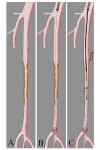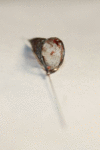Use of the directional atherectomy for the treatment of femoro-popliteal lesions in patients with critical lower limb ischemia
- PMID: 27896226
- PMCID: PMC5120749
Use of the directional atherectomy for the treatment of femoro-popliteal lesions in patients with critical lower limb ischemia
Abstract
Femoro-popliteal PTA for the treatment of critical limb ischemia is frequently associated with unsatisfactory procedural success rates while directional atherectomy (DCA) has improved success rate since claudicant patients undergoing percutaneous treatment of femoro-popliteal obstructive disease. The aim of this prospective study is to evaluate the safety, efficacy and procedural success of DCA, at one year, in the percutaneous treatment of femoro-popliteal obstructive disease in patients with critical limb ischemia.
Methods: From March 2012 to March 2013 18 consecutive patients with critical limb ischemia were treated with DCA (Turbohawk/Covidien-ev3 Endovascular Inc., North Plymouth, Minnesota, USA) for the treatment of femoro-popliteal obstructive disease. Patients were evaluated at 12 months.
Results: Technical and procedural success was achieved in every patient. No in-hospital major adverse cardiovascular events occurred. Primary endpoint: freedom from any amputation was obtained in all patients. Secondary endpoints: clinical (Rutherford class improvement) and hemodynamic success (Ankle-brachial index improvement) was achieved in all patients.
Conclusion: The use of DCA for the treatment of femoro-popliteal obstructive disease is a safe and effective therapeutic strategy for patients with critical limb ischemia. The data included in our study should be considered hypothesis-generating in order to design of a randomized trial comparison with conventional PTA.
Keywords: Turbohawk device; atherectomy; critical limb ischemia; endovascular treatment.
Figures




References
-
- Norgren L, Hiatt WR, Dormandy JA, Nehler MR, Harris KA, Fowkes FG, et al. Inter-Society Consensus for the Management of Peripheral Arterial Disease (TASC II) Eur J Vasc Endovasc Surg. 2007;33( Suppl 1):S1–75. - PubMed
-
- Minar E. Critical limb ischaemia. Hamostaseologie. 2009;29:102–9. - PubMed
-
- Schonefeld E, Schonefeld T, Osada N, Austermann M, Torsello G. Long stents for long femoropopliteal lesions-first results of 128 Protégé stents. Zentralbl Chir. 2009;134:310–5. - PubMed
-
- Rutherford RB, Baker JD, Ernst C, Johnston nKW, Porter JM, Ahn S, Jones DN. Recommended standards for reports dealing with lower extremity ischemia: revised version. J Vasc Surg. 1997;26:517–38. - PubMed
-
- Roberts D, Niazi K, Miller W, Krishnan P, Gammon R, Schreilber T, et al. DEFINITIVE Ca++ Investigators. Effective endovascular treatment of calcified femoropopliteal disease with directional atherectomy and distal embolic protection: final results of the DEFINITIVE Ca++ trial. Catheter Cardiovasc Interv. 2014;84:236–44. - PMC - PubMed
LinkOut - more resources
Full Text Sources
